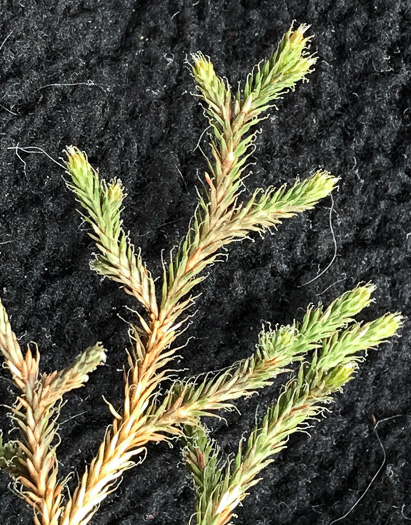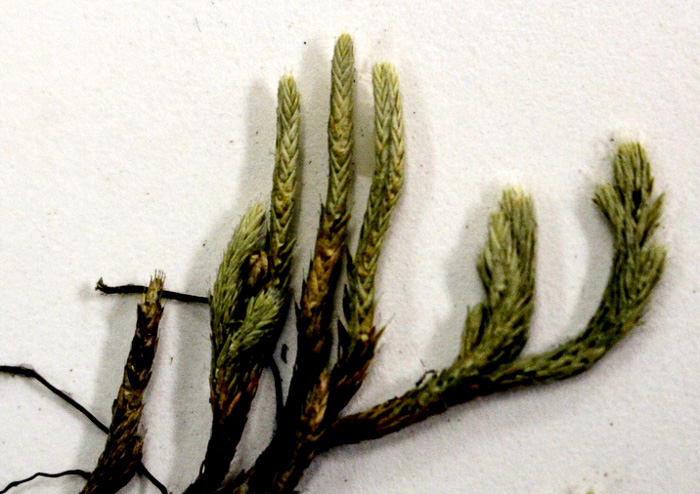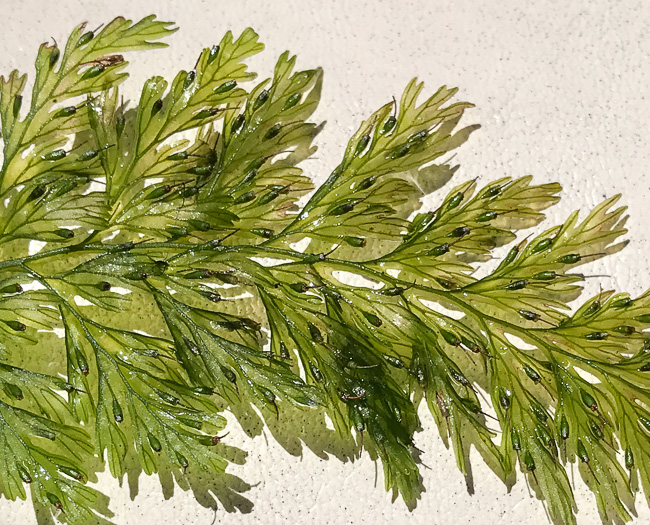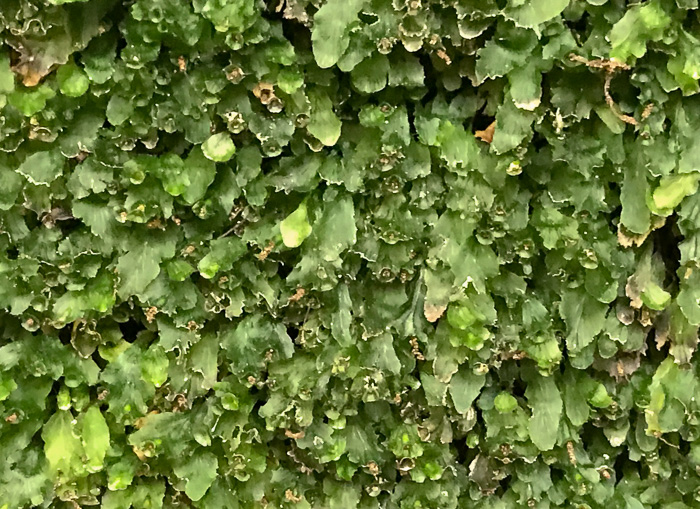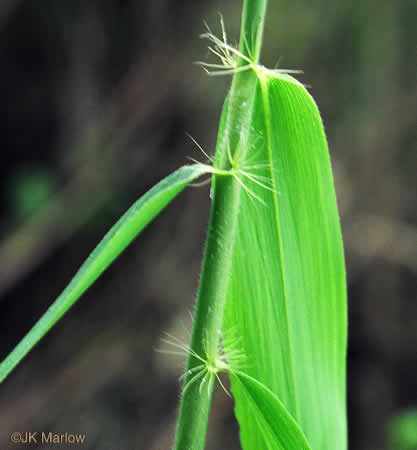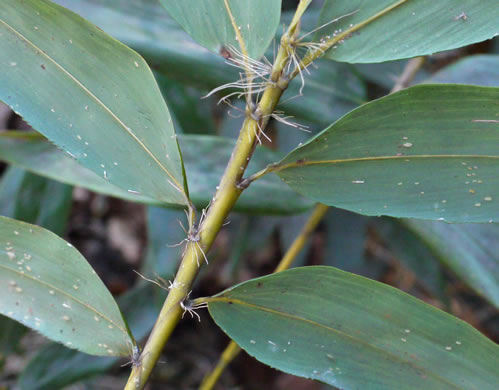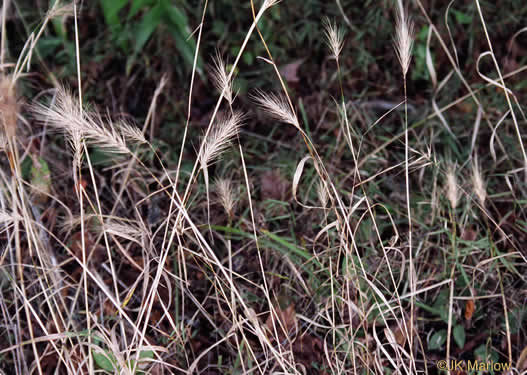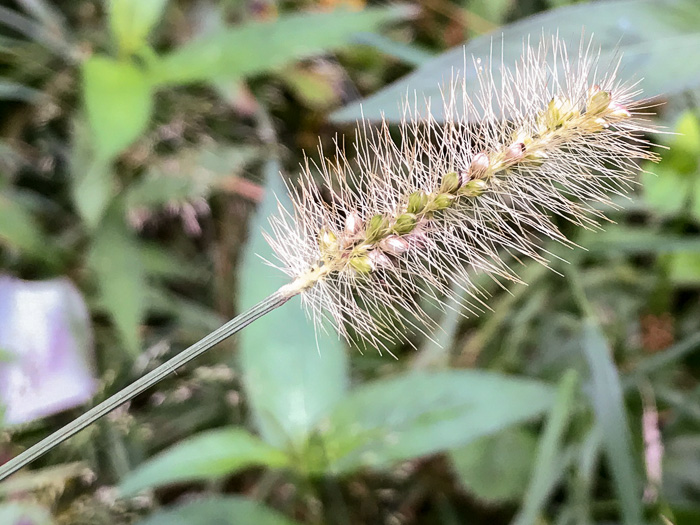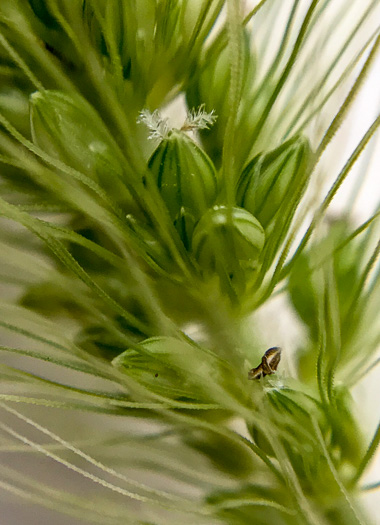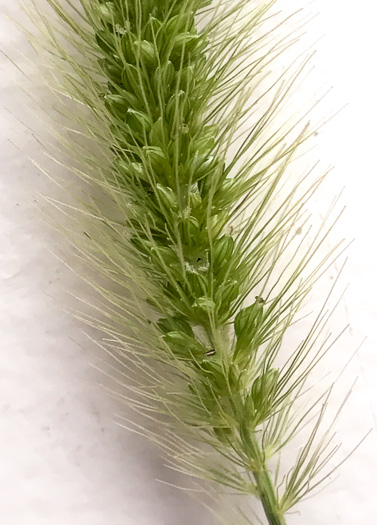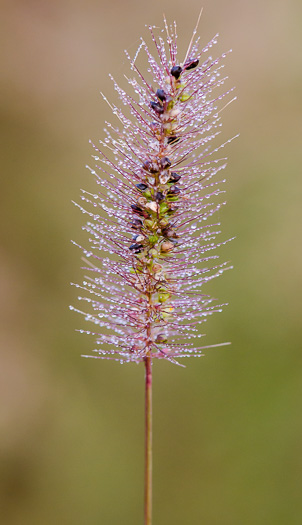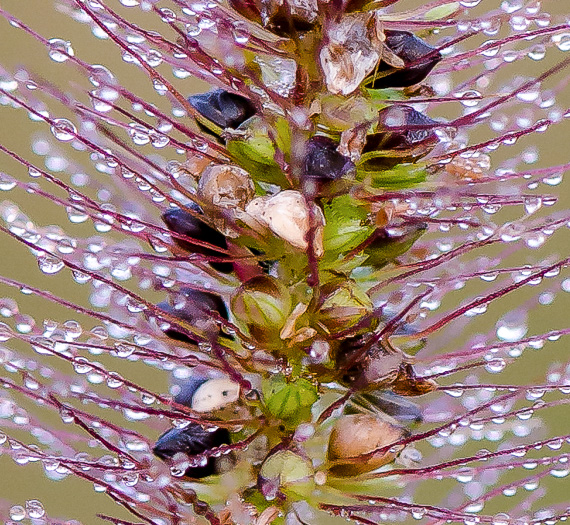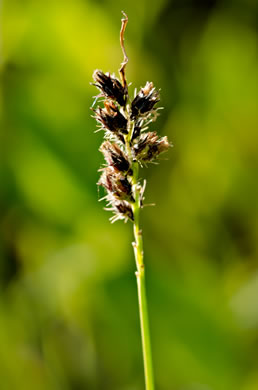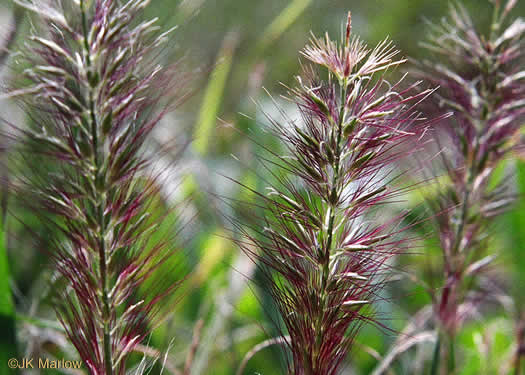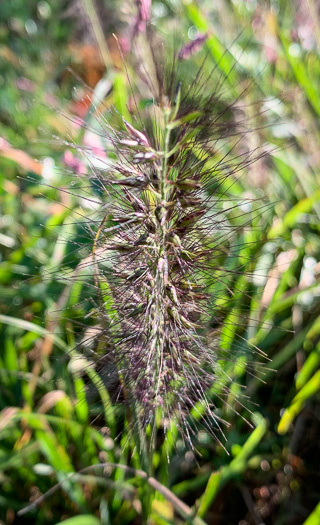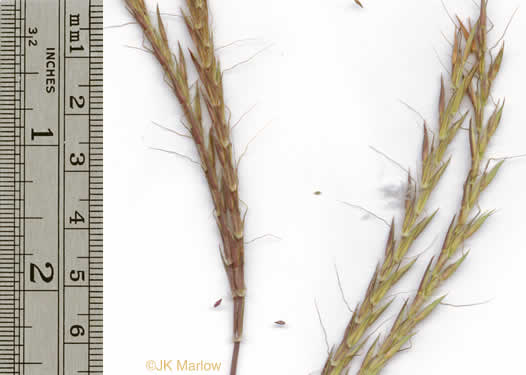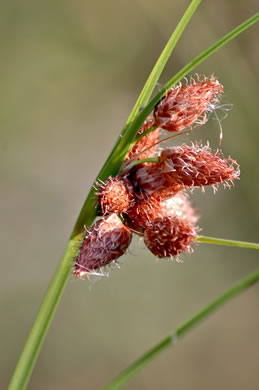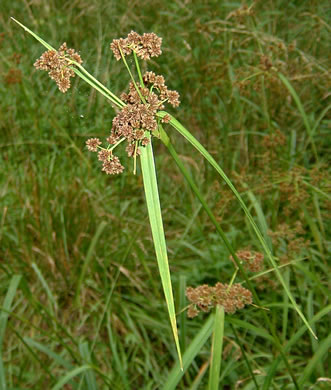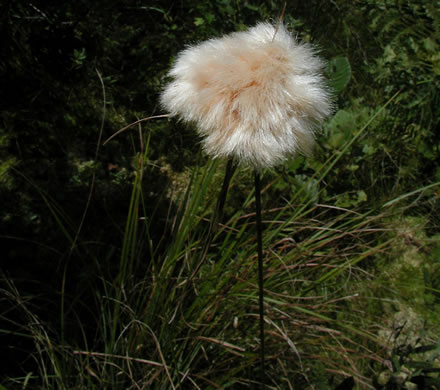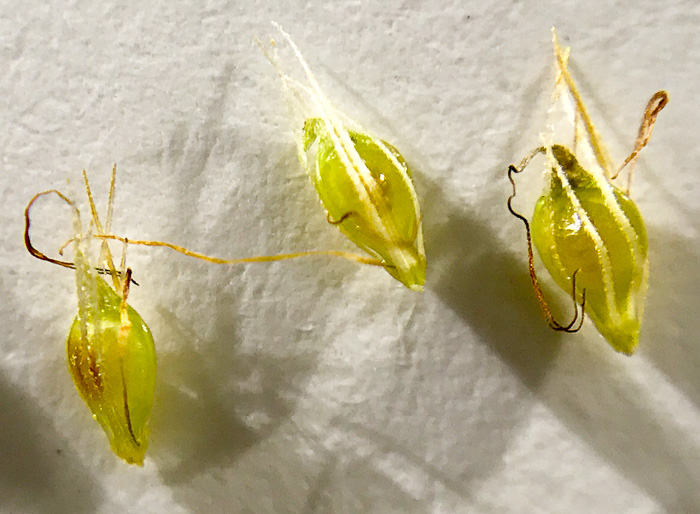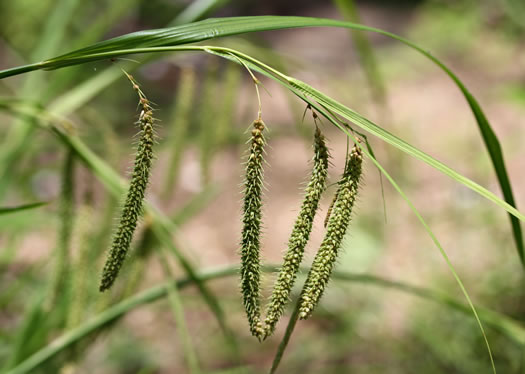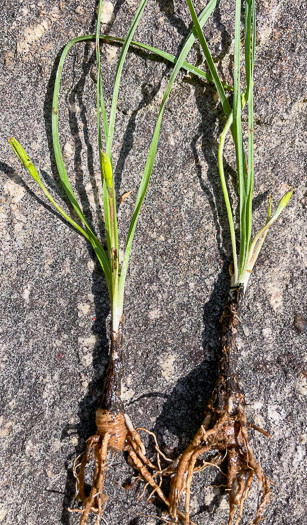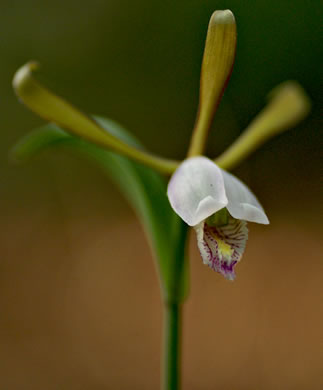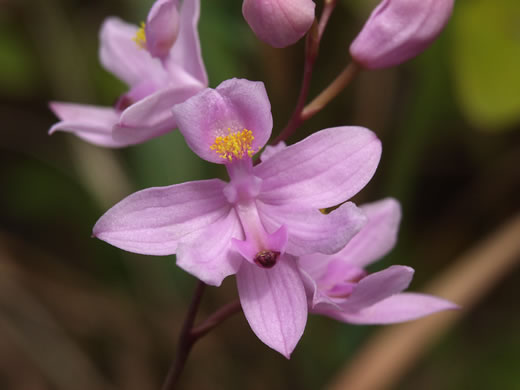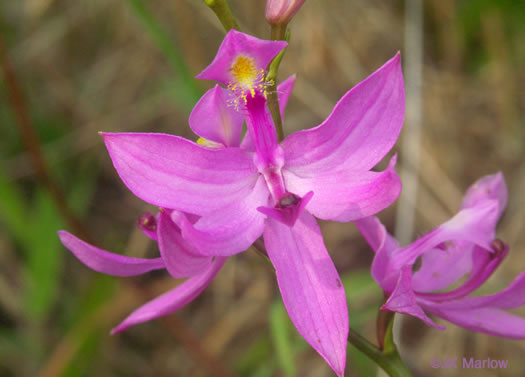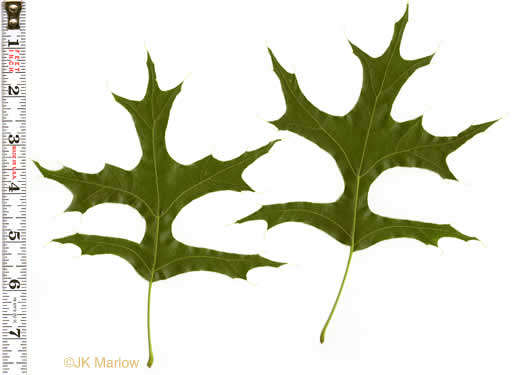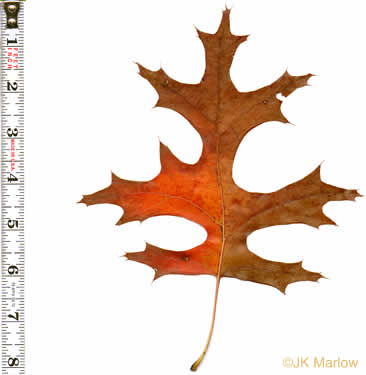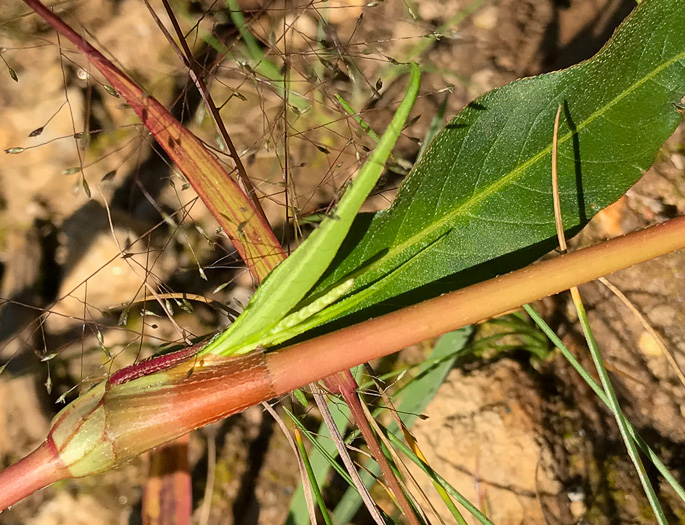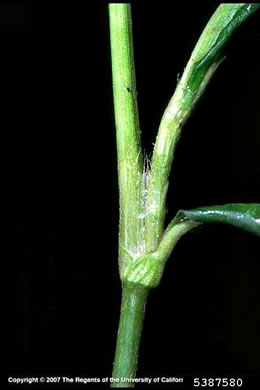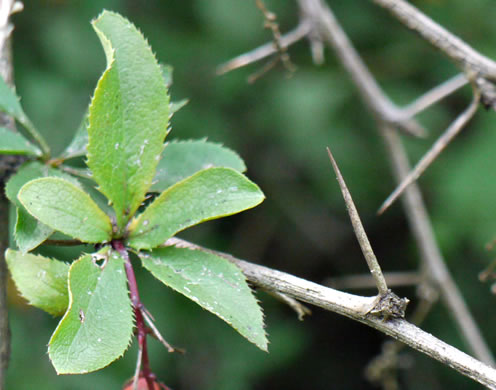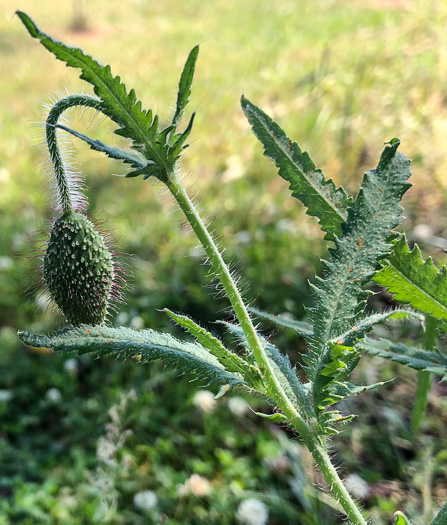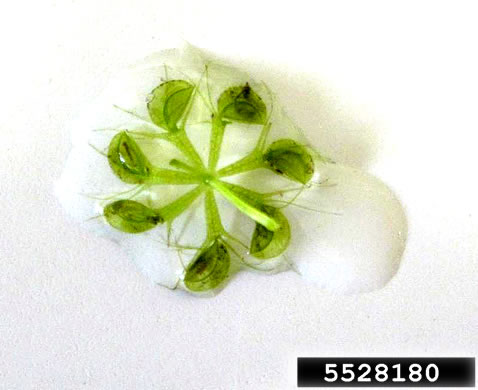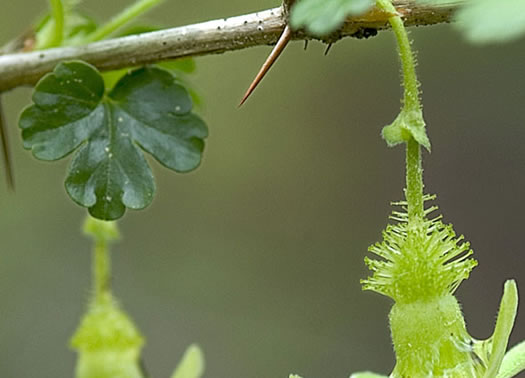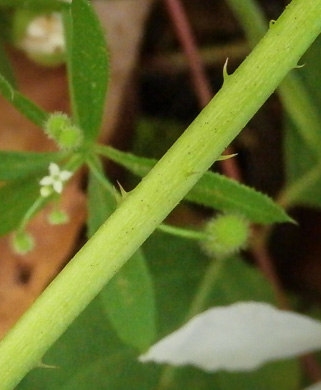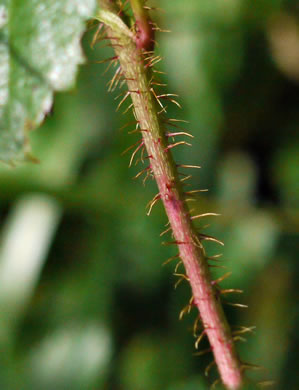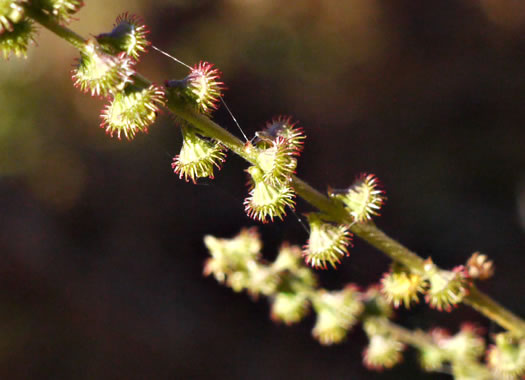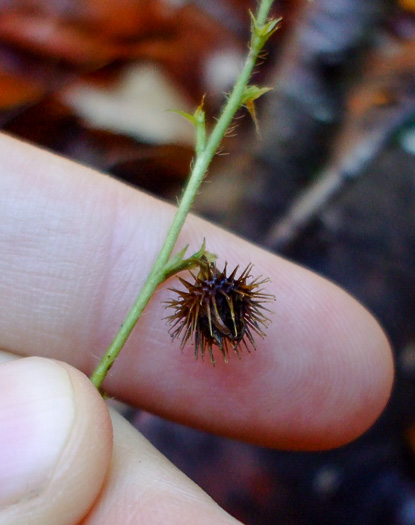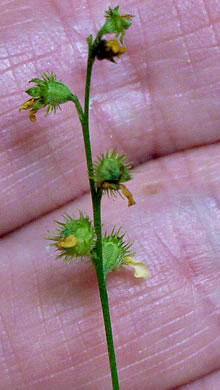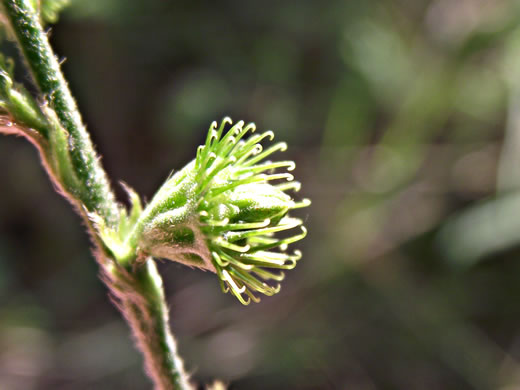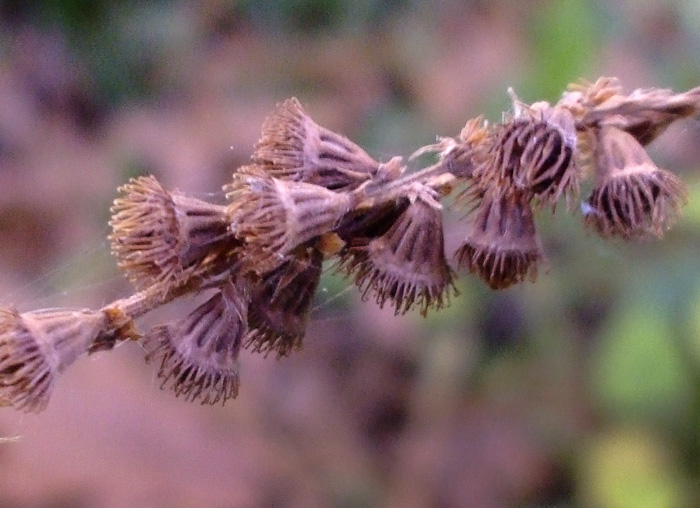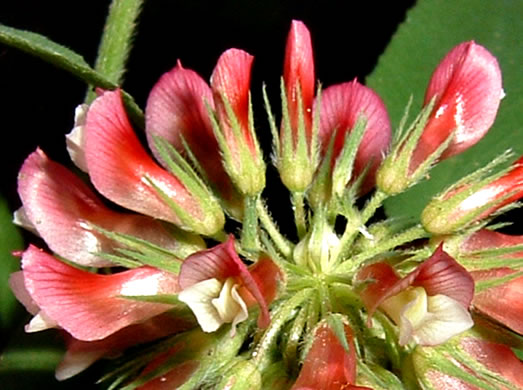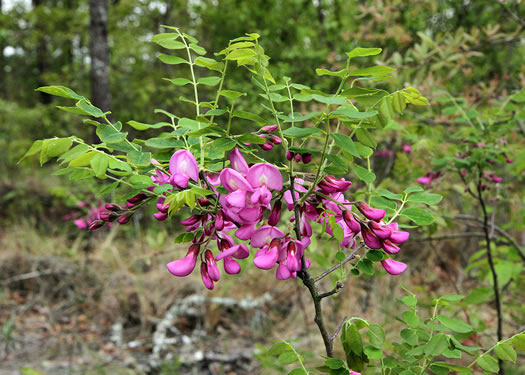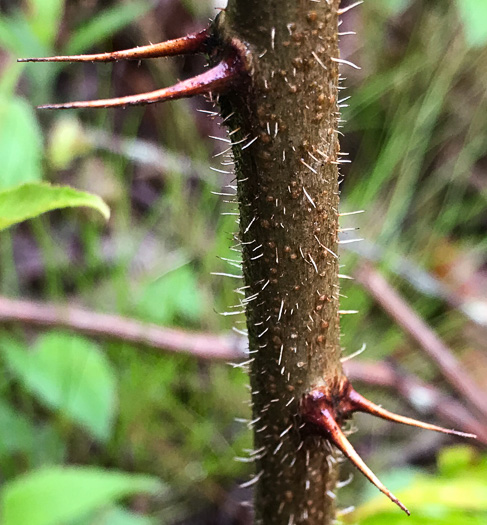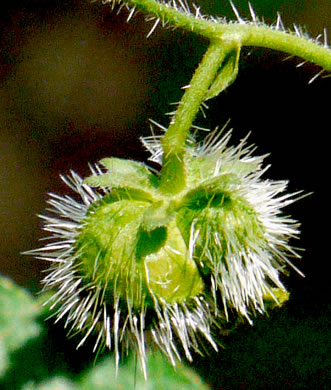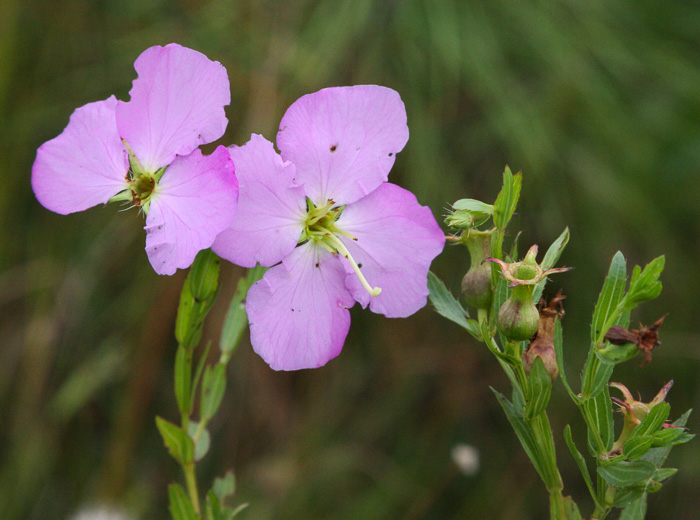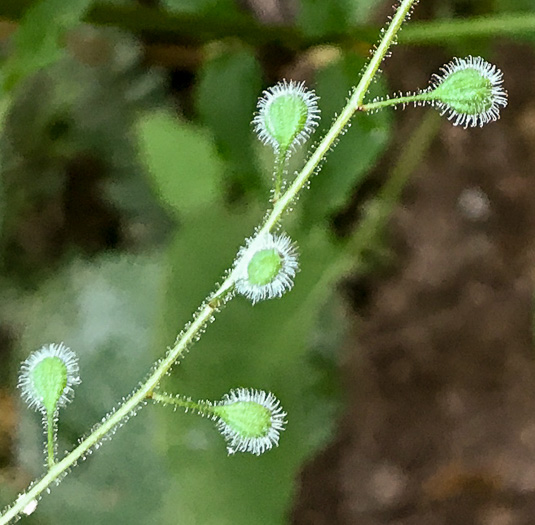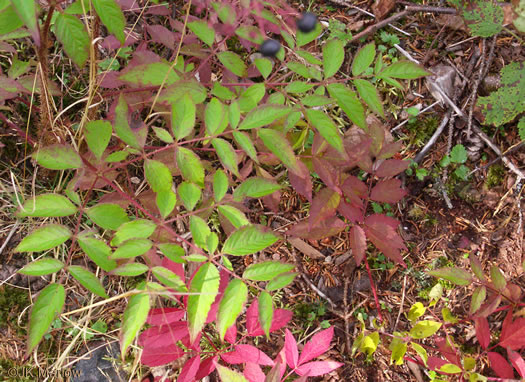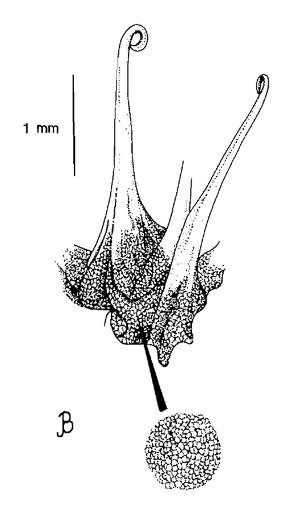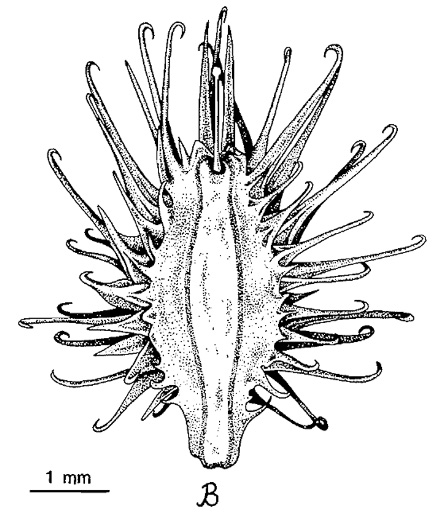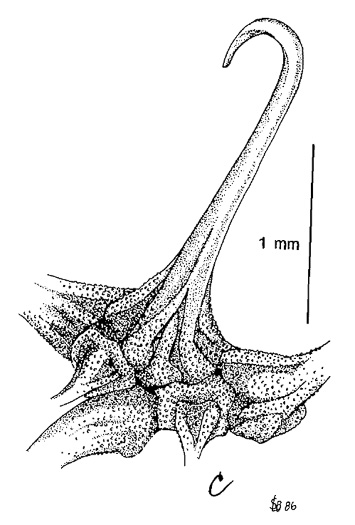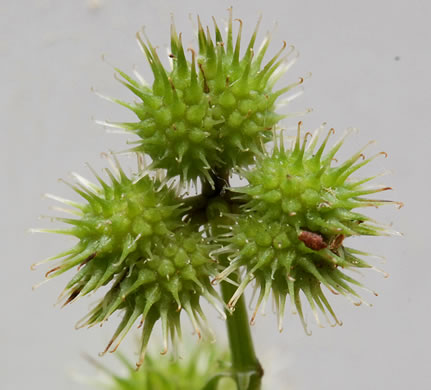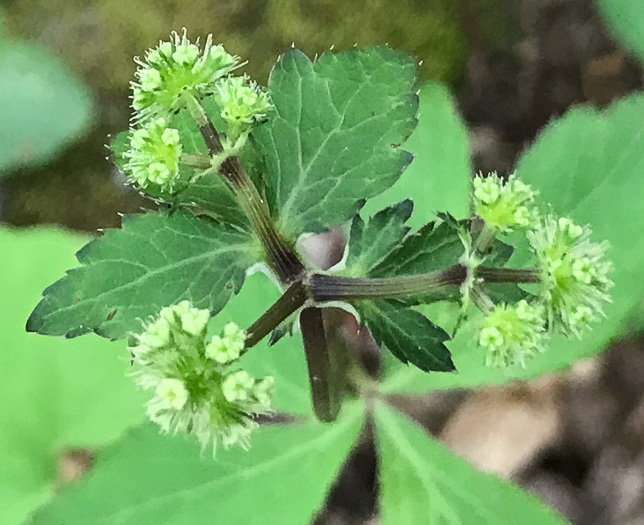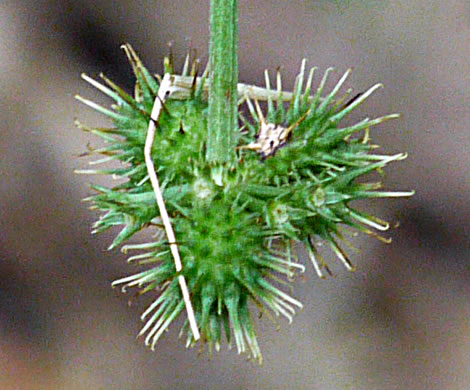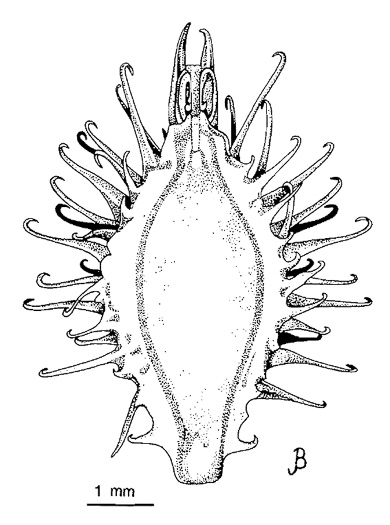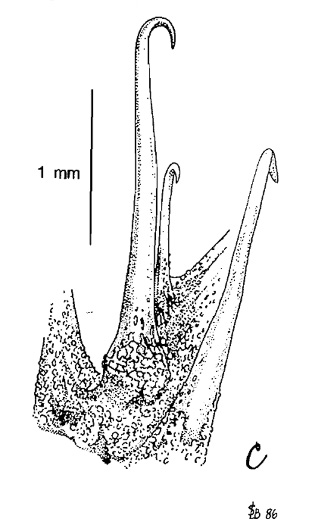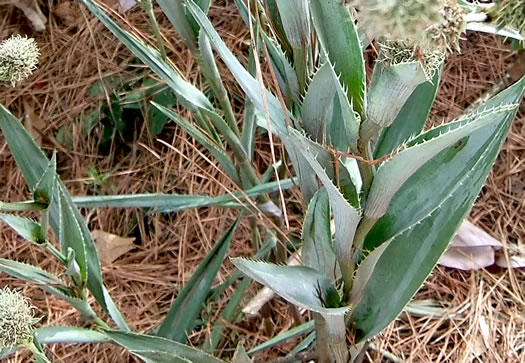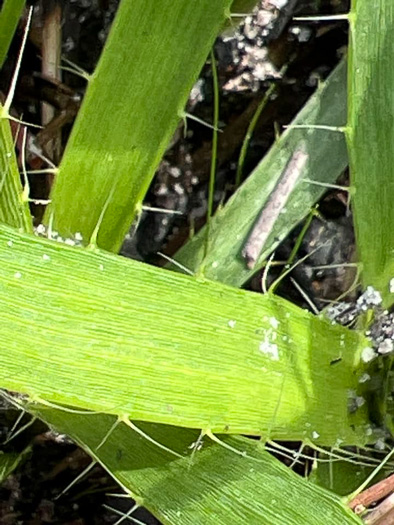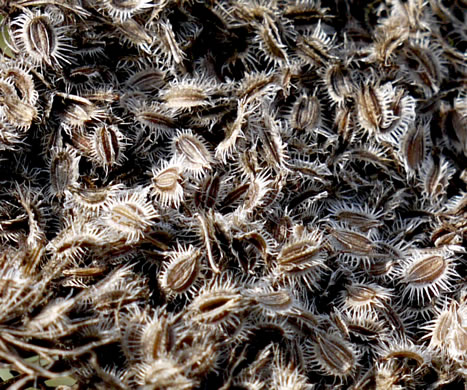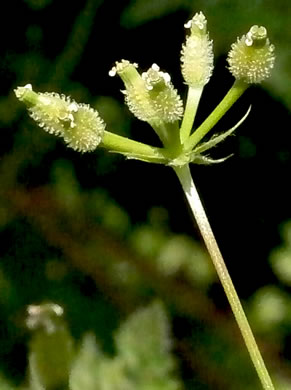Your search found 97 image(s) illustrating the term "bristles." For a written explanation, click on "bristles" in the Glossary.
PAGE 1 PAGE 2
To see larger pictures, click or hover over the thumbnails.
To go to the plant's detail page, click its name.
 Twisted-hair Spikemoss,
Bryodesma tortipilum
Twisted-hair Spikemoss,
Bryodesma tortipilum
The small, tightly overlapping, linear leaves have apical, twisted bristles, per Wildflowers & Plant Communities of the Southern Appalachian Mountains and Piedmont (Spira, 2011).
 Rock Spikemoss,
Bryodesma rupestre
Rock Spikemoss,
Bryodesma rupestre
The overlapping lvs are small, narrow & gray-green w white terminal bristles and marginal hairs, per Guide to the Plants of Granite Outcrops (Murdy & Carter, 2000).
 Appalachian Filmy-fern,
Vandenboschia boschiana
Appalachian Filmy-fern,
Vandenboschia boschiana
Sporangia borne on stalks or bristles projecting from conelike indusia, per Peterson Field Guide to Ferns of Northeastern and Central North America.
 Dwarf Filmy-fern,
Didymoglossum petersii
Dwarf Filmy-fern,
Didymoglossum petersii
Sporangia borne on stalks or bristles projecting from conelike indusia, per Peterson Field Guide to Ferns of Northeastern and Central North America.
 River Cane,
Arundinaria gigantea
River Cane,
Arundinaria gigantea
Bristles 6-9mm long on both sides of the throat, per Forest Plants of the Southeast and Their Wildlife Uses (Miller & Miller, 2005).
 Giant Timber Bamboo,
Phyllostachys bambusoides
Giant Timber Bamboo,
Phyllostachys bambusoides
Leaf sheaths with 2 tufts of bristles on auricles, per Woody Plants of the Southeastern US: A Winter Guide (Lance, 2004).
 Virginia Wild-rye,
Elymus virginicus
Virginia Wild-rye,
Elymus virginicus
Can be confused with Secale cereale which often nods but has longer bristles, per Grasses, an Identification Guide (Brown, 1979).
 Perennial Foxtail-grass,
Setaria parviflora
Perennial Foxtail-grass,
Setaria parviflora
Spikelets 2-2.5 or even 3mm long; bristles 1-3x or even 6x long as spikelet, per Manual of the Grasses of the United States (Hitchcock & Chase, 1950).
 Yellow Foxtail,
Setaria pumila
Yellow Foxtail,
Setaria pumila
Longer bristles 2-3x as long as the spikelet, per Manual of the Grasses of the United States (Hitchcock & Chase, 1950).
 Yellow Foxtail,
Setaria pumila
Yellow Foxtail,
Setaria pumila
4-12 bristles below each spikelet, per Weakley's Flora (2020).
 Coastal Plain Bristlegrass,
Setaria corrugata
Coastal Plain Bristlegrass,
Setaria corrugata
Bristles green or purple, to 2cm long - much exceeding the spikelets, per Manual of the Grasses of the United States (Hitchcock & Chase, 1950).
 Coastal Plain Bristlegrass,
Setaria corrugata
Coastal Plain Bristlegrass,
Setaria corrugata
Bristles 1-3 below each spikelet, per Vascular Flora of the Carolinas (Radford, Ahles, & Bell, 1968).
 Slimbristle Sandspur,
Cenchrus brownii
Slimbristle Sandspur,
Cenchrus brownii
Most outer bristles equaling or slightly exceeding inner, flattened bristles, per Utah State University: Intermountain Herbarium.
 Tender Fountaingrass,
Cenchrus setaceus
Tender Fountaingrass,
Cenchrus setaceus
Pennisetum's spikelets are surrounded by an involucre of bristles, per Manual of the Grasses of the United States (Hitchcock & Chase, 1950).
 Chinese Fountaingrass,
Cenchrus purpurascens
Chinese Fountaingrass,
Cenchrus purpurascens
Softly bristly panicles 8-15cm long; bristles of the fascicles to 2cm long, per Manual of the Grasses of the United States (Hitchcock & Chase, 1950).
 Big Bluestem,
Andropogon gerardi
Big Bluestem,
Andropogon gerardi
Bristles (awns) that project from the flowers are sharply bent, per Book of Field and Roadside (Eastman, 2003).
 Saltmarsh Bulrush,
Bolboschoenus robustus
Saltmarsh Bulrush,
Bolboschoenus robustus
Inflorescence relatively congested, most w 5-20 spikelets; bristles ~ caducous, per Weakley's Flora.
 Georgia Bulrush,
Scirpus georgianus
Georgia Bulrush,
Scirpus georgianus
Spikelets in umbellate clusters or heads. Nutlets whitish; bristles us. absent, per Vascular Flora of the Carolinas (Radford, Ahles, & Bell, 1968).
 Tawny Cottongrass,
Eriophorum virginicum
Tawny Cottongrass,
Eriophorum virginicum
Produces many long, soft, cotton-like bristles when in fruit, per Wild Flowers of NC, 2nd edition (Justice, Bell, & Lindsey, 2005).
 Clustered Beaksedge,
Rhynchospora glomerata
Clustered Beaksedge,
Rhynchospora glomerata
Perianth bristles 6, overtopping tubercle, antrorsely barbellate, per Flora of North America.
 Long-fringed Sedge,
Carex crinita var. crinita
Long-fringed Sedge,
Carex crinita var. crinita
Female flower clusters to 4" long, covered with stiff bristles, drooping on long slender stalks, per Field Guide to the Wildflowers of Georgia (Chafin, 2016).
 Glossyseed Stargrass,
Hypoxis sessilis
Glossyseed Stargrass,
Hypoxis sessilis
Unlike H. rigida, the base of the plant does not have numerous stiff bristles, per Vascular Flora of the Carolinas (Radford, Ahles, & Bell, 1968).
 Appalachian Dragonhead Pogonia,
Cleistesiopsis bifaria
Appalachian Dragonhead Pogonia,
Cleistesiopsis bifaria
The protruding lip has purple markings and a blotch of yellow bristles, per Wild Orchids of South Carolina: A Popular Natural History (Fowler, 2005).
 Bearded Grass-pink,
Calopogon barbatus
Bearded Grass-pink,
Calopogon barbatus
The bright yellow bristles on the lip resemble stamens full of pollen, per Wild Orchids of South Carolina: A Popular Natural History (Fowler, 2005).
 Common Grass-pink,
Calopogon tuberosus var. tuberosus
Common Grass-pink,
Calopogon tuberosus var. tuberosus
Upper petal (lip) narrow, spreading to a triangular tip w orange bristles, per Wildflowers of Tennessee, the Ohio Valley, and the Southern Appalachians (Horn, Cathcart, Hemmerly, & Duhl, 2005).
 Pin Oak,
Quercus palustris
Pin Oak,
Quercus palustris
Leaves deeply 5-7 lobed, sinuses rounded, larger lobes with 3+ bristles, per Trees of the Southeastern United States (Duncan & Duncan, 1988).
 Scarlet Oak,
Quercus coccinea
Scarlet Oak,
Quercus coccinea
Leaves deeply 5-9 lobed, sinuses rounded, larger lobes with 3+ bristles, per Trees of the Southeastern United States (Duncan & Duncan, 1988).
 Spotted Lady's-thumb,
Persicaria maculosa
Spotted Lady's-thumb,
Persicaria maculosa
Bristles of ocreae 0.2-1.3 (-2) mm long, per Weakley's Flora (2020).
 Spotted Lady's-thumb,
Persicaria maculosa
Spotted Lady's-thumb,
Persicaria maculosa
Similar to P. longiseta, but bristles on the leaf node collars only 2mm long, per Wildflowers of the Sandhills Region (Sorrie, 2011).
 European Barberry,
Berberis vulgaris
European Barberry,
Berberis vulgaris
Leaf margins finely serrate, each w (8)16-30 teeth tipped w spines or bristles, per Flora of North America.
 Corn Poppy,
Papaver rhoeas
Corn Poppy,
Papaver rhoeas
Plants hispid to setulose [covered with minute bristles], per Flora of North America.
 Waterwheel-plant,
Aldrovanda vesiculosa
Waterwheel-plant,
Aldrovanda vesiculosa
Leaf whorls 1-2cm in diam., bristles extending slightly beyond leaf blade, per Flora of China.
 Miccosukee Gooseberry,
Ribes echinellum
Miccosukee Gooseberry,
Ribes echinellum
Ovary and fruit are densely covered in long, gland-tipped bristles, per Guide to the Wildflowers of SC, 1st ed. (Porcher & Rayner, 2001).
 Common Dewberry,
Rubus flagellaris
Common Dewberry,
Rubus flagellaris
Stems armed with stout-based and usually recurved prickles (bristles lacking), per Weakley's Flora.
 Swamp Dewberry,
Rubus hispidus
Swamp Dewberry,
Rubus hispidus
Slender stems trailing on ground, terete, with bristles, per Native Shrubs and Woody Vines of the Southeast (Foote & Jones, 1989).
 Southern Agrimony,
Agrimonia parviflora
Southern Agrimony,
Agrimonia parviflora
Hypanthium with several rows of hooked bristles encloses the single nutlet, per Vascular Flora of the Carolinas (Radford, Ahles, & Bell, 1968).
 Common Agrimony,
Agrimonia gryposepala
Common Agrimony,
Agrimonia gryposepala
Fruiting hypanthia's hooked bristles in 4-5 circumferential rows, proximal row reflexed, per Flora of North America.
 Woodland Agrimony,
Agrimonia rostellata
Woodland Agrimony,
Agrimonia rostellata
Fruiting hypanthia hemispheric, hooked bristles in 2-3 circumferential rows, per Flora of North America.
 Downy Agrimony,
Agrimonia pubescens
Downy Agrimony,
Agrimonia pubescens
Hypanthium with several rows of hooked bristles enclosing the single nutlet, per Vascular Flora of the Carolinas (Radford, Ahles, & Bell, 1968).
 Roadside Agrimony,
Agrimonia striata
Roadside Agrimony,
Agrimonia striata
Fruiting hypanthia's hooked bristles in 3-4 circumferential rows, proximal row spreading, per Flora of North America.
 Buffalo Clover,
Trifolium reflexum
Buffalo Clover,
Trifolium reflexum
Calyx lobes subulate [awl-shaped], setaceous [having bristles], < 0.4mm wide, per Weakley's Flora.
 Dwarf Bristly Locust,
Robinia nana
Dwarf Bristly Locust,
Robinia nana
Resembling R. hispida (Bristly Locust) but lacking its bristles. — Will Stuart
 Kelsey's Locust,
Robinia hispida var. kelseyi
Kelsey's Locust,
Robinia hispida var. kelseyi
Twigs glabrous or with a few bristles, per Woody Plants of the Southeastern US: A Winter Guide (Lance, 2004).
 Nettleleaf Noseburn,
Tragia urticifolia
Nettleleaf Noseburn,
Tragia urticifolia
Spherical capsule in 3s, 4-10mm wide, greenish with white bristles, per Forest Plants of the Southeast and Their Wildlife Uses (Miller & Miller, 2005).
 Awned Meadowbeauty,
Rhexia aristosa
Awned Meadowbeauty,
Rhexia aristosa
The long yellowish bristles at the summit of the calyx/hypanthium are diagnostic, per Weakley's Flora (2022).
 Canada Enchanter's Nightshade,
Circaea canadensis
Canada Enchanter's Nightshade,
Circaea canadensis
Fruit uncinate-bristly [the bristles have hooks at their tips], per Vascular Flora of the Carolinas (Radford, Ahles, & Bell, 1968).
 Bristly Sarsaparilla,
Aralia hispida
Bristly Sarsaparilla,
Aralia hispida
Lower stem beset w slender bristles, also several bipinnate cauline leaves, per Wildflowers of the Southern Mountains (Smith, 1998).
 Black Snakeroot,
Sanicula marilandica
Black Snakeroot,
Sanicula marilandica
Bases of fruit bristles prominently bulbous & with a minutely warty-reticulate surface pattern, per A synopsis of the genus Sanicula (Apiaceae) in eastern Canada (Pryer & Phillippe, 1989).
 Canada Sanicle,
Sanicula canadensis var. canadensis
Canada Sanicle,
Sanicula canadensis var. canadensis
Style shorter than sepals; inconspicuous sepals straight and about equalling uppermost bristles, per A synopsis of the genus Sanicula (Apiaceae) in eastern Canada (Pryer & Phillippe, 1989).
 Canada Sanicle,
Sanicula canadensis var. canadensis
Canada Sanicle,
Sanicula canadensis var. canadensis
Bases of fruit bristles dilated, ridged, and often minutely papillose, per A synopsis of the genus Sanicula (Apiaceae) in eastern Canada (Pryer & Phillippe, 1989).
 Canada Sanicle,
Sanicula canadensis var. canadensis
Canada Sanicle,
Sanicula canadensis var. canadensis
Fruit pedicellate, bristles in indistinct rows w swollen bases [& hooked tips], per Vascular Flora of the Carolinas (Radford, Ahles, & Bell, 1968).
 Small's Sanicle,
Sanicula smallii
Small's Sanicle,
Sanicula smallii
Calyx lobes shorter than bristles, divergent; petals white or greenish, per Vascular Flora of the Carolinas (Radford, Ahles, & Bell, 1968).
 Small's Sanicle,
Sanicula smallii
Small's Sanicle,
Sanicula smallii
Sepals on mature fruit somewhat spreading, immersed in adjacent fruit bristles, per Weakley's Flora.
 Beaked Sanicle,
Sanicula trifoliata
Beaked Sanicle,
Sanicula trifoliata
Style shorter than sepals; sepals w subulate, incurved tips exceeding uppermost bristles, per A synopsis of the genus Sanicula (Apiaceae) in eastern Canada (Pryer & Phillippe, 1989).
 Beaked Sanicle,
Sanicula trifoliata
Beaked Sanicle,
Sanicula trifoliata
Bases of fruit bristles dilated and minutely white-patchy, per A synopsis of the genus Sanicula (Apiaceae) in eastern Canada (Pryer & Phillippe, 1989).
 Northern Rattlesnake-master,
Eryngium yuccifolium var. yuccifolium
Northern Rattlesnake-master,
Eryngium yuccifolium var. yuccifolium
Larger leaves > 1.5 cm wide; marginal bristles of leaves solitary, per Weakley's Flora (2023).
 Southern Rattlesnake-master,
Eryngium yuccifolium var. synchaetum
Southern Rattlesnake-master,
Eryngium yuccifolium var. synchaetum
Larger lvs < 1.5cm wide; marginal bristles in fascicles, lower fascicles usually w 2-3 bristles, per Weakley's Flora (2023).
 Ravenel's Eryngo,
Eryngium ravenellii
Ravenel's Eryngo,
Eryngium ravenellii
Leaves w primary veins pinnate-reticulate, with or without marginal bristles, per Weakley's Flora.
 Queen Anne's Lace,
Daucus carota ssp. carota
Queen Anne's Lace,
Daucus carota ssp. carota
Bristles of fruit simple or weakly uncinate, rarely weakly glochidiate, per Vascular Flora of the Carolinas (Radford, Ahles, & Bell, 1968).
 Bur Chervil,
Anthriscus caucalis
Bur Chervil,
Anthriscus caucalis
Mericarps densely beset with hooked (uncinate) bristles, ribs obsolete, per Weakley's Flora (2015).

